And the mistakes I’ve made, SO FAR.
Here’s what I did wrong. I’m going to be happy that this list, as far as I’m aware, is short.
1. I grew cantaloupe from the seeds of store-bought cantaloupes. To be fair to myself, I didn’t know any better! So don’t do the same thing — sure it’s tempting, but hybrids, if you bought one from the store (most of them are hybrids, apparently), will give you heartache or at least some stress. Read on to find out why. To those I gave seedlings, I will report my findings as I find them out, and I greatly apologize for any grief you experience!
2. I took a picture of the giant grasshopper, and it got away. I’m still kicking myself about this one, and it only happened yesterday. The babies are hard enough to catch. If you see a big one, don’t try to capture the awe in regards to its size or even impressive markings. Just kill it. It will eat and make babies. Something eats bits of my corn, and I blame him. Or them.
Here’s what I’m doing right (again, as far as I’m aware). Top-Ten List! Top-Ten List That’s Really in No Particular Order!
10. I gave my cantaloupe seedlings a raised bed and trellis in which to grow to their heart’s content without getting trampled by dogs.
9. I learned about square-foot gardening and went ahead and spent the big bucks to give them a good soil in which to grow. Even the in-ground pumpkins got a healthy dose of compost mixed into their soil spots.
8. I lovingly give them water each day, and I know to hold back on water as fruit maturity begins to happen.
7. I learned the difference between male and female flowers and what “self-fertile but not self-fertilizing” plants are.
6. I learned about and am quite willing to help my cantaloupes’ pollination. I don’t have many bees here yet, so I have to do what I can to help (I did see one of those big black ones this morning, but he didn’t linger long at the cantaloupe flowers; I also see an occasional sweat bee).
5. I check them each day for bugs and kill anything that looks menacing. Unless it gets away while I’m taking a picture, that is…
4. I’m being a good mom by growing the cantaloupes at my son’s request, and along the way I get to teach my kids about plant life cycles and good gardening practices (and/or my mistakes!).
3. I gently guide the cantaloupe vines up the trellis to give them something to hang on to.
2. I learned about companion planting and put in marigolds and corn in their raised bed.
1. And most importantly, I love them and talk to them and love them some more!
And there you have it. I’m so excited to have thriving cantaloupe plants, but I’m worried that I’m growing a hybrid. So I’m seeking words of wisdom from the experienced cantaloupe gardeners out there! And Cat at AmloFarms has some blooming male flowers (from REAL seeds) she can share with me for pollination purposes. This cantaloupe thing is getting pretty complicated, haha. But for the sake of my cantaloupes, I will drive across town and back! Thank you, Cat!
The cantaloupes are happily growing up their trellis and trying to grow out wide, too.
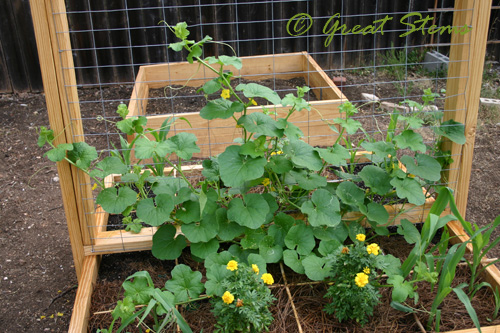
We’ve had male flowers for awhile, and today (day 38) I found my first female. Here’s how you tell the difference. The easiest way is looking at the flower stem.
The male rises from the vine with a single plain stem of its own.
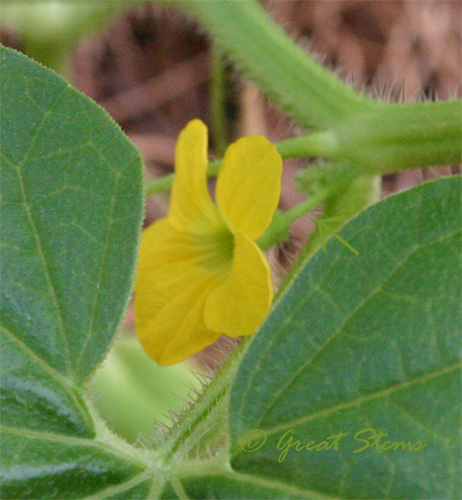 The female has a cute little bulge that will become the fruit if pollinated.
The female has a cute little bulge that will become the fruit if pollinated.
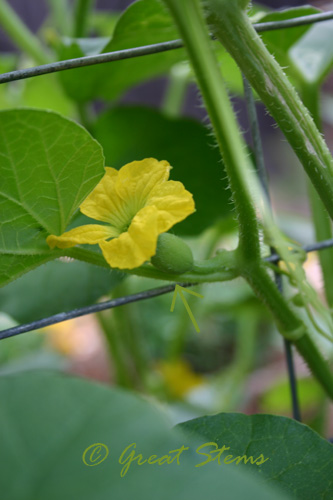
Here’s a baby female bud.
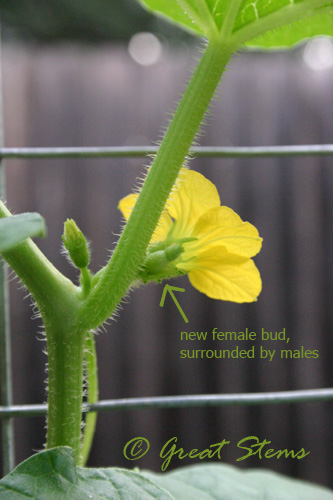 You can also tell the difference by looking at the inside of the bloom, but here’s where I’m unsure about the condition of the inside of my cantaloupe blooms. The male stamens will have pollen, but I can’t tell whether mine do, haha.
You can also tell the difference by looking at the inside of the bloom, but here’s where I’m unsure about the condition of the inside of my cantaloupe blooms. The male stamens will have pollen, but I can’t tell whether mine do, haha.
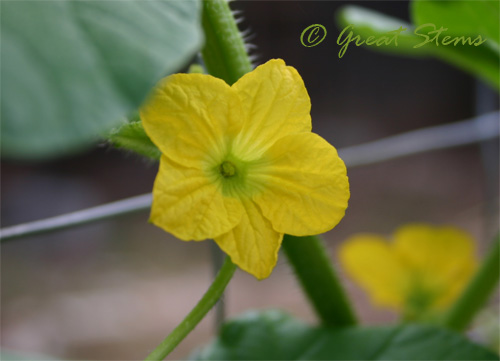 And the females will have their stigma ready to receive pollen. But mine look quite green, so I don’t know if mine look the way they should (I’ve seen pics with them yellow).
And the females will have their stigma ready to receive pollen. But mine look quite green, so I don’t know if mine look the way they should (I’ve seen pics with them yellow).
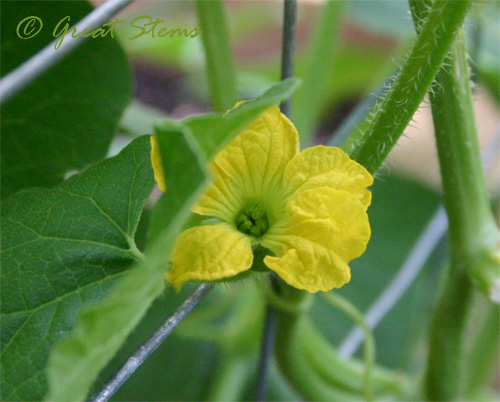 All the same, I did my best to get some pollen from the male to the female. At first I tried q-tips and a paintbrush, but I saw hardly any yellow on either. So I finally pulled off some male flowers and exposed their stamens and rubbed them on the female.
All the same, I did my best to get some pollen from the male to the female. At first I tried q-tips and a paintbrush, but I saw hardly any yellow on either. So I finally pulled off some male flowers and exposed their stamens and rubbed them on the female.
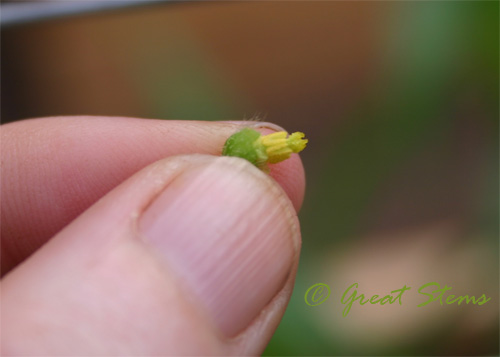
No idea whether any pollen grains stuck.
So experienced cantaloupe gardeners, should I be seeing lots of yellow pollen on the males? The male pumpkin flower (just saw my first two today!) has a lot of pollen, that’s for sure. And ants. First blooms, day 38.
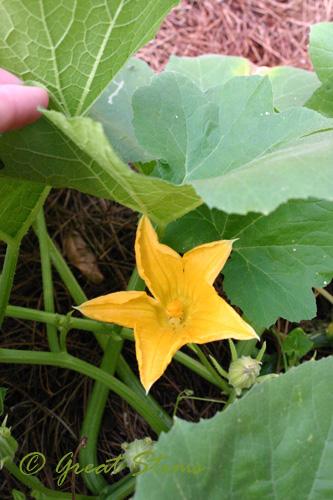
Here’s one of the giant plants. They have a long way to go to reach full size. Egads.
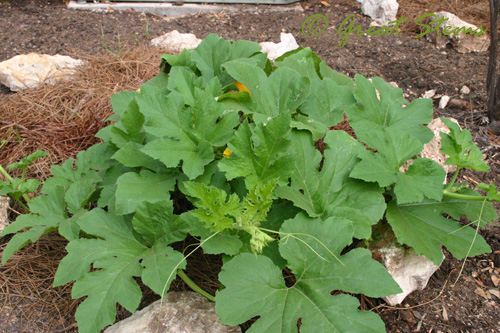 From what I’ve read, if I read correctly, the female flowers should be ok and just the males might be sterile. But I don’t know whether the females are sometimes sterile, too. And even if pollination happens, will I get a regular cantaloupe out of it or some dud?
From what I’ve read, if I read correctly, the female flowers should be ok and just the males might be sterile. But I don’t know whether the females are sometimes sterile, too. And even if pollination happens, will I get a regular cantaloupe out of it or some dud?
And while I’m asking, let me ask this: Can someone identify this red bug for me? The bigger versions of it are black, but I don’t see any of those on the garden yet, but last fall I had a ton of all sizes in a bunch of fallen leaves. Even the people at Natural Gardener couldn’t name them for me. I kill them when I see them now. But I’d like to know what they are. They are not tiny lady bugs, that’s all I know.
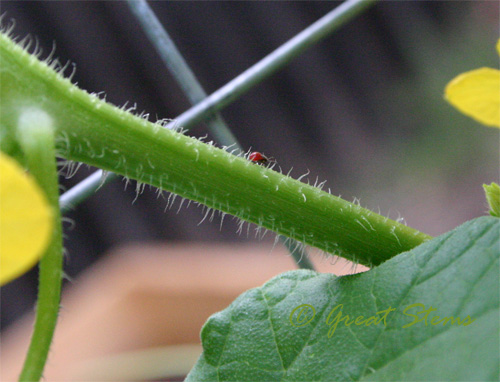
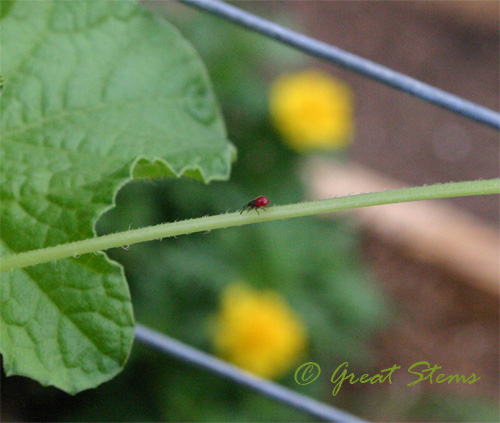 In other garden news, I decided to do something with my broken tools. Please tell me this looks like a flower, because it’s supposed to, HA! I will probably paint it at some point, but it’s growing on me (hehe) as is, too.
In other garden news, I decided to do something with my broken tools. Please tell me this looks like a flower, because it’s supposed to, HA! I will probably paint it at some point, but it’s growing on me (hehe) as is, too.
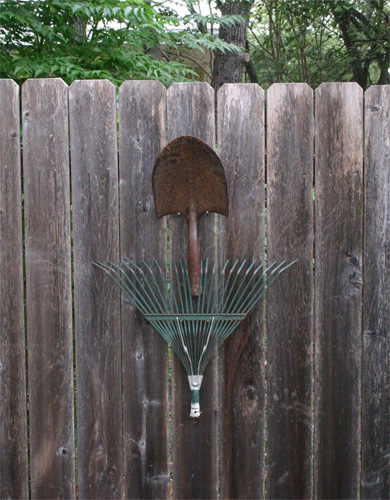
You can see the evil chinaberry in my very nice neighbor’s yard behind it — it’s been my nemesis for many a year. My neighbor finally had it cut down several months ago, but the workers left the stump and roots, so of course it’s been growing back with a vengeance. We cut it again just to prevent seeds and it’s back — so the neighbor is getting the tree people back out to properly kill it. Not sure they’ll succeed if they don’t get the roots out. I’m having to close my eyes and ears about the herbicides they’ll probably use… But I’m so thrilled to have a neighbor who is trying to help with the invasives problem!
Sugar pumpkins continue to grow and confuse me. They just aren’t eager to send out tendrils, but growing they be, with new bloom buds forming.
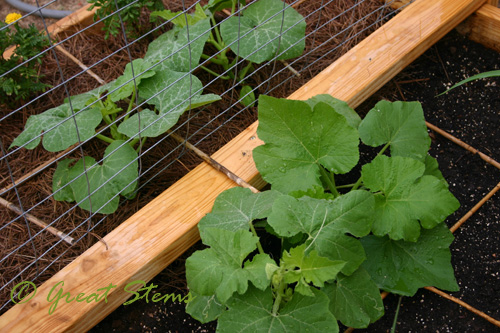 Marigold seedlings! Only about 6 took, but I have more seeds to try with.
Marigold seedlings! Only about 6 took, but I have more seeds to try with.
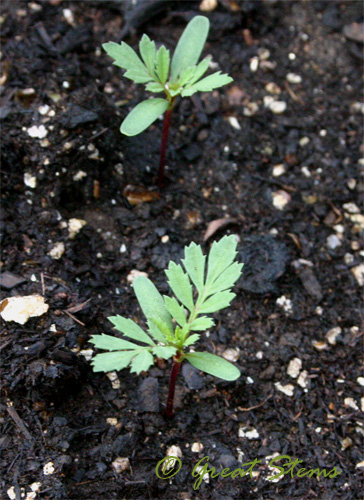 And much of my corn is happy. A few seedlings are getting chomped by something <evil eye at grasshoppers, even if they aren’t to blame>, but the rest are growing. I never really realized how beautiful a corn plant is until all this growing stuff.
And much of my corn is happy. A few seedlings are getting chomped by something <evil eye at grasshoppers, even if they aren’t to blame>, but the rest are growing. I never really realized how beautiful a corn plant is until all this growing stuff.
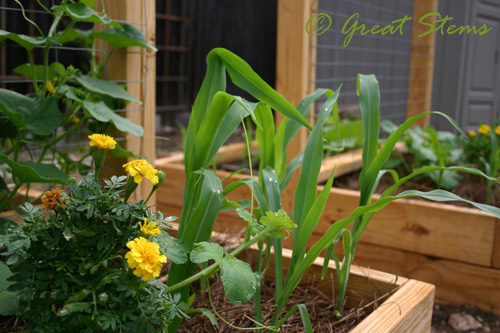 And I’ve planted 8 pole bean seeds so far. I’m making use of the far corners of the trellis squares (ok, according to square-foot gardening, those squares belong to the cantaloupes but they were just sitting there empty! seemed so wasteful). I’ll be planting more along the fence once I amend the soil. My wonderful oldest son dug out the weeds from that area for me this morning. This whole “raising kids to work on the farm” was a brilliant plan of the pioneering farmers!
And I’ve planted 8 pole bean seeds so far. I’m making use of the far corners of the trellis squares (ok, according to square-foot gardening, those squares belong to the cantaloupes but they were just sitting there empty! seemed so wasteful). I’ll be planting more along the fence once I amend the soil. My wonderful oldest son dug out the weeds from that area for me this morning. This whole “raising kids to work on the farm” was a brilliant plan of the pioneering farmers!
I planted Black-Seeded Blue Lake Pole Beans. The seeds look like engorged ticks. Don’t they sound wonderful? But I hear they are delicious. No, really. Really!
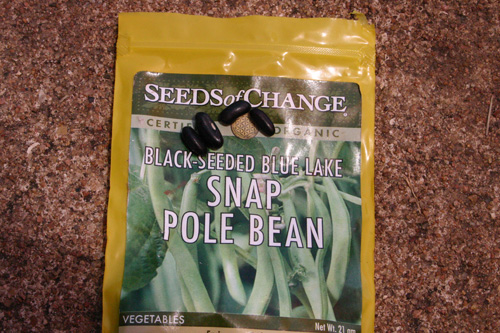
And we had another frog in the dog pond. Not surprisingly, he’s just as cute as Murray! Pictures soon!
Too bad about the grasshopper! But hybrid cantaloupe or not, those look like thriving, vibrant plants. I hope something good comes out of them.
oh your plants look tons healthier than mine..hahah! i’ve just about given up on my veggie garden and am ready to seriously focus on the fall stuff…heheeh and the flowers on my cantaloupes are blooming so just let me know when you are ready! 🙂
I love these pictures!! They really help explain the whole fruit sex thing. Have you read The $64 Tomato? It’s hilarious about a guys quest to have an organic garden. There’s a part in it when goes around with a paint brush.
I have tons of boxelder bugs and when they’re young,the’re red and shaped a bit like your red bug. As adults, they’re black with a red zig zag on it. Maybe google it and see if this is your bug? Your ornament reminds me of a passion flower. Great blog!!
Okay, I just have to ask about your beds. Or more specifically, your trellis arrangements. I really like the look of those. I have a square foot garden, and I made the trellis from the book with pipe and tomato netting (or whatever it’s called). Works fine, but it’s on one side of the bed, not in the middle. Maybe I could move it. Hmmm.
Anyway, how are those attached to the bed? Nails? Bolts? Are just the uprights attached, or are the horizontal boards nailed on, too?
You plants are just gorgeous! How the heck do you keep them so lush and green? I mean, you’re not getting any more rain than we are in San Antonio I would think. I’ve pretty much given up on the summer garden and am looking forward to fall.
Love your blog!
Wendy, I’m glad you like the photos. I haven’t read the book, but I added it to my wish list — I’m sure I can relate! I’ve looked up the boxelder bug before, but I’m pretty sure it isn’t the same bug. The bigger versions of the bugs look similar to the red ones, just black. They are very round in shape, too. It’s been a mystery that I hope to one day solve!
Betsy, I’ve really loved the trellises — I’m glad you like them, too. My husband says, “The beds and the trellis frames are all attached together with wood screws. The horizontal boards are screwed in place as well.” They are remarkably sturdy — we’ll see how they withstand the test of time. You can see the frames in this post: http://www.greatstems.com/2009/07/pumpkin-army-bases-day-15.html
A little easier to look at without all the plants in the way! The vegetable garden is the only thing I’m trying to water regularly, and because it’s my first garden, I think that’s why I’ve not had too many bugs yet. I’m sure they’re heading this way, though! And next year I might not be so lucky…
Thanks for stopping by my blog. I like your photos, especially the one of the frog. Is sounds like you are doing wonderful things with your garden. I have no idea about the red bug, but are you sure it isn’t a spider? If so, maybe you should let them live and they will help control pests? I have such a hard time killing anything.
I wish these were spiders. I’d let them live for sure. Believe me, I hate killing things. Or if they just ate dead leaves, I’d let them live. But last year they feasted on a mona lavender plant of mine, contributing to sickly leaves and stems. So I don’t want them on my veggies and fruits! I’m learning that grasshoppers have to go. And stink bugs. And leaf-footed bugs. And squash vine borer moths and eggs. But until I know a bug to be a true pest, it is innocent until proven guilty!
Great stems….I’m laughing…..You get that too? lol
Beautiful photos, Meredith. What is the camera you are using?
I was happy to read your #9 on the Top Ten list. Good soil is critical!! Yea for you!!
Thanks for visiting my blog. For a “newbie”, your efforts are commendable. Keep it up!
Thank you, Lynn. I still have so much to learn and am no way near ready to give up my newbie status! But I’m trying to learn! I’m certainly crossing the line into obsessive gardener — though one could say that saying the word “gardener” automatically implies “obsessive,” haha. Oh, I use an older model of the Canon Digital Rebel most of the time.
I really enjoyed looking at your blog. You have a great garden! Maybe one day I will start my own vegetable garden. One thing at a time. Loved the wanted posters and bunny!! 🙂
Dittos on the blog. We grew some cantaloupe from seeds a while back and they grew, but the flavor was terrible. It could have well been that we didn’t hold back on water as the fruit matured.
Good luck with them.
Meredith, I have learned so much from you. I don’t do vegetable/fruit gardening, but this was informative! Thank you. Hey, I did a little research on your red bug. Plug in the name Hemipterans Pictures into Google search and it brings up pictures similar to the one you posted. I guess there are several different varieties, but I saw pictures of those like the one you posted. Hope that helps! Try this link:
http://www.whatsthatbug.com/2009/02/23/aggregation-of-unknown-red-hemipterans-in-brazil/
I hope this helps!
Hmmm, similar, but I don’t think they’re the same. What I need to find is a local entomologist! Thank you for searching for me. One time I ran across someone else trying to find out the same exact bug, but it was never identified, either. If I hadn’t found that, I’d declare mine a new species and name them after me! I might do that anyway, until I know better, HA!
Greetings,
I just happened upon your site while googling for cantaloupe info and found it very interesting! You have lovely photos as well.
I am growing cantaloupe for the first time this year and am starting to get fruit…and starting to get nervous. I just want to try and help them survive as much as possible and as a first time gardener I’m afraid they will all either stop growing, die or taste boring. AGH!
So, I was wondering how yours turned out? I have mine in a box as well with a fence behind it for trellis and these things are growing like mad. I have about 15 fruit so far ranging in size from softball to golf ball. I have read people suggest making hammocks from panty hose to support the fruit hanging on the trellis as it gets larger and am wondering if you found you needed to do this and if so, do you have any pictures? If you do, would you mind posting them? I’d greatly appreciate it 🙂
Thanks so much. And again, great site!
Well, my cantaloupe were both wonderful and terrible at the same time. I had a great experience growing them, and I got several large and beautiful cantaloupes. Plus I learned soooo much. They were huge plants. However, I knew they would taste bad because I grew them from the seeds of a store-bought cantaloupe, and I learned belatedly that those are usually hybrids and not ones to use for seeds. Then I got lots of aphids and sooty mold, which was also ok because I used the cantaloupe as a trap for the aphids and kept them off my pumpkins.
I did in fact make slings for the cantaloupes — here’s the post: http://www.greatstems.com/2009/08/rock-a-bye-baby.html
Good luck! Let me know how they turn out!
Thanks ! Very helpful even though it took a while to find a female. (but isn’t that true in all nature 🙂
Is it possible that i dont have any male flowers on my canteloupe? I have TONS of yellow flowers and the leaves are full but I can’t find one male flower. I am in west florida, and I am successfully growing green peppers, cucumbers and corn in this same g arden. help
Beth, I definitely went through a period with my pumpkins where I had only male flowers blooming and, then female flowers without males. It was quite nerve-wracking, but eventually I had some open at the same and rushed to help with the pollination. With my canteloupe, I had males only for a long time before the females finally started to appear. If you have only females (with the little ovaries visible), perhaps you can find someone with male flowers that you can borrow for pollination? I almost had to do that myself.
I thought I was reading my own account of yesterday in the world of cantaloupes (except for talking to them). Your pictures of the male flower are exactly what I need to proceed with manual pollination. In Arizona even the bees don’t come out when it’s 118 degrees.
Great info and an enjoyable read.
Thanks, Mark! Good luck with your cantaloupes — I’m glad the info was helpful. Yes, the pollinators are absent right now, with the heat and drought we’re having.
You have a great blog!. I just when’t to see if I could get my cantaloupe to pollinate and found that I have 5 already!
Ryan, I know I’m late in responding — that’s great news about your canteloupe. How did they turn out?
I am having the same problems i can not decipher what is male and female i have sent a link to my pic’s any help would be much appreciated thanks and please keep up the blog i am enjoying it so much xx
https://www.facebook.com/media/set/?set=a.2141891305613.109619.1196110909&type=3&l=5cc424281c
here is the link i do not know if i posted it in the right place x
Hi, Maria. It’s hard to see, but I think I’m seeing the small females on the blurry photo. The timing sure can be frustrating with the males and females, but it might have something to do with temperature. With patience, those males might show up!
Thank you so much for responding 🙂 , maybe it is the weather here in the uk that melons find hard , I expect so cos I do too lol ,will update my pics soon , do not know if i sent you the link to our garden ,just so you can see what i am trying to grow, this is my first year of growing veg and it has motivated me to try again next year,maybe on a bigger scale all depends how i am xx
https://www.facebook.com/media/set/?set=a.3730408737556.142820.1196110909&type=3&l=dbe2f3bc7b
here is a pic from today not ver clear sorry but i am sure i have plenty of females
https://www.facebook.com/media/set/?set=a.3730408737556.142820.1196110909&type=1&l=dbe2f3bc7b
You and me both, Maria — I would love to garden on a bigger scale, but first I need to be better about watering consistently. As for growing melons in the UK — I definitely can’t offer any advice, as Texas is quite different! But I know there are a lot of UK garden bloggers — perhaps they have shared their experiences with melons. Good luck!
just sending you some pics of my melons i have actually grown , well they are only babies right now but i am so proud of them also my corn is doing well so we can grow them over here in the uk hope all is well with you and your family x
It’s so great to hear that your garden is doing well, Maria. Thanks for sharing!
https://www.facebook.com/media/set/?set=a.3730408737556.142820.1196110909&type=3&l=dbe2f3bc7
So I planted store bought organic cantaloupes, and planted the seeds, I have fruits that look more like a cross between a cucumber and a squash, is this stuff any good to eat still? My plants look beautiful, lots of flowers and fruits, just not what I was expecting.
All I can suggest is to try them, but they might not work out. I know what you are experiencing!
Question: My cantaloupe, cucumbers and Zucchini are blooming profusely but all the blooms are male. Any idea why? My Yellow Squash is doing pretty much the same thing although I do have a few squash growing after hand pollinating every bloom I see with a paintbrush.
The males come out first, Chuck — the timing sure is strange, but that’s how it is! I hope you managed to get some melons and squash this summer!